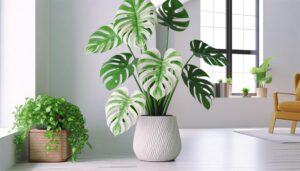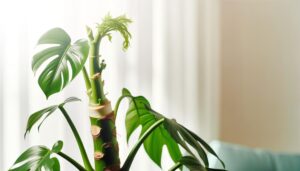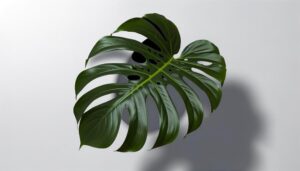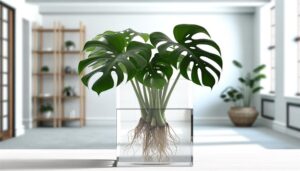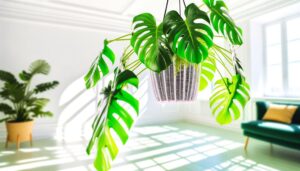Monstera Epipremnoides for Sale Usa: Best Deals!
If you are looking for Monstera Epipremnoides for sale in the USA in 2024, you can try checking online marketplaces like Etsy or eBay, or visit local nurseries and plant stores. Be sure to inspect the leaves and petioles carefully to ensure you are buying the right plant.
Comparison Table of Monstera Epipremnoides and Other Rare Varieties
| Variety | Description | Price Range |
|---|---|---|
| Monstera Epipremnoides | South American origin, bright indirect light | Out of stock |
| Monstera Borsigiana ‘White Monster’ | Dramatic white and green variegation | $400 – $6,000 |
| Monstera Deliciosa ‘Marilyn’ | Stable mix of yellow and green variegation | $200 – $2,500 |
| Monstera ‘Creme Brulee’ | Leaves almost entirely cream-colored | $2,000 – $8,000 |
| Monstera Burle Marx ‘Flame’ | Distinctive leaf shape and pattern | $1,500 – $5,000 |
| Monstera Esqueleto | Extensive fenestrations and unique leaf structure | $300 – $3,000 |

Key Takeaways
- Check online retailers like The Sill and Etsy for Monstera epipremnoides.
- Visit top-rated local plant shops for purchasing Monstera epipremnoides.
- Prices vary from $50 to $200 based on size and variegation.
- Factor in seller reputation and shipping costs when buying.
- Consider the plant’s size and variegation before purchasing.
Key Features of Monstera Epipremnoides
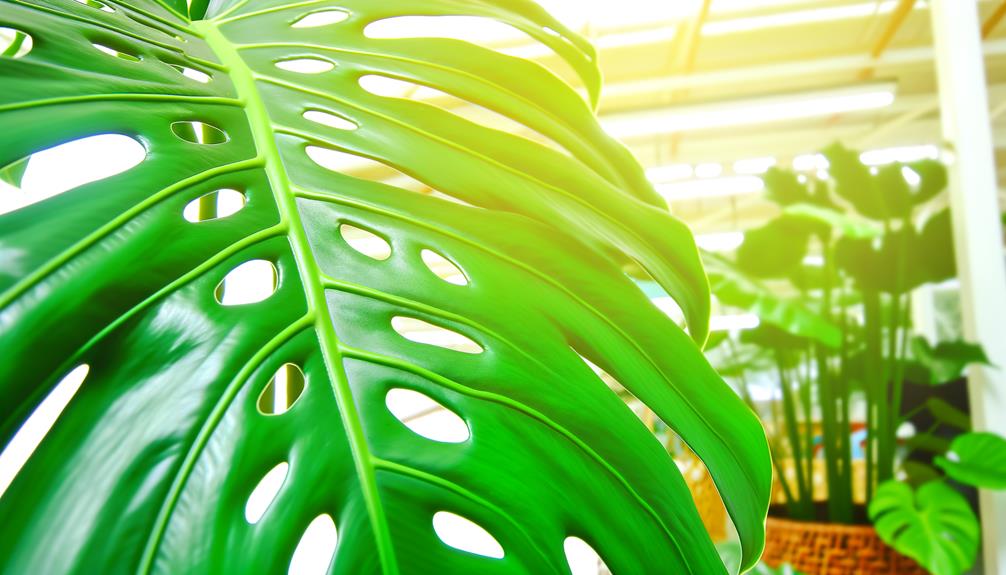
Monstera epipremnoides, recognized for its punctured leaves and robust growth, thrives in bright, indirect sunlight and well-draining soil. You’ll notice its appealing fenestrations, which set it apart from other Monstera species. These natural holes aid the plant in enduring strong winds and heavy rains in its native tropical environments.
When cultivating Monstera epipremnoides, use a potting mix containing peat, perlite, and orchid bark to enhance aeration. Regularly misting the leaves maintains the necessary humidity. Prune occasionally to manage its rapid growth and to encourage a bushier form. Water when the top inch of soil feels dry, avoiding waterlogging to prevent root rot.
Fertilize monthly during the growing season with a balanced, water-soluble fertilizer for best health.
Benefits of Owning Monstera Epipremnoides
Owning Monstera epipremnoides offers several benefits, including improved indoor air quality and an aesthetically pleasing addition to your plant collection. This species, known for its unique perforated leaves, enhances oxygen levels and filters airborne toxins.
Proper cultivation involves placing it in indirect sunlight and maintaining humidity levels between 60-80%. The most favorable temperature range is 18-27°C (64-81°F). Watering should be consistent but not excessive; the soil should remain moist but not waterlogged. Utilizing well-draining soil with a high organic matter content will support healthy growth.
Regularly wiping the leaves prevents dust accumulation, enhancing photosynthesis. Additionally, Monstera epipremnoides can be propagated via stem cuttings, making it easy to expand your green space.
Online Retailers in the USA
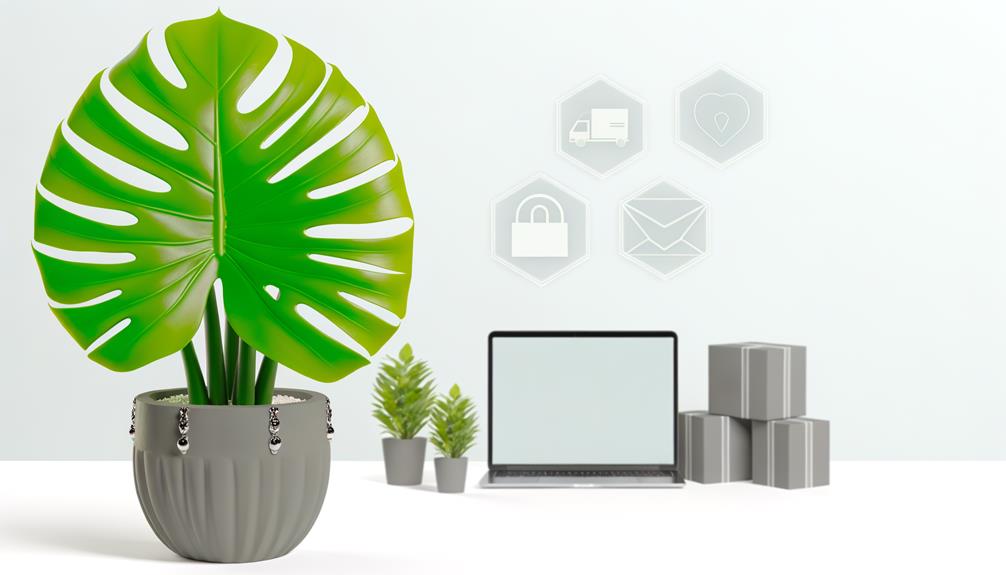
Several reputable online retailers in the USA offer Monstera epipremnoides, providing a convenient option for acquiring this unique plant species. Websites like The Sill, Etsy, and Plant Proper are known for their high-quality specimens.
When purchasing, guarantee the plant arrives in good condition by checking seller reviews and shipping policies.
Monstera epipremnoides, often confused with Monstera adansonii, prefers bright, indirect light and well-draining soil. It thrives in humidity levels above 60% and requires regular watering, allowing the soil to partially dry between waterings. To support its climbing habit, provide a moss pole or trellis.
Local Plant Shops to Check
You should explore top-rated local plant shops, renowned for their diverse rare plant collections, including Monstera epipremnoides.
These shops often provide expert advice on best soil mixes, humidity levels, and light conditions.
Don’t forget to inquire about their propagation techniques to maximize your plant’s growth.
Top-Rated Local Shops
Many plant enthusiasts swear by the exceptional quality and knowledgeable staff at local shops like The Sill in New York City, Pistils Nursery in Portland, and Logee’s Plants in Connecticut for sourcing Monstera epipremnoides.
When selecting a plant, make sure it has healthy, green leaves with no signs of pests or disease. Proper cultivation involves maintaining high humidity levels, ideally above 60%, and placing the plant in indirect, bright light.
Use a well-draining soil mix, such as one composed of peat, perlite, and orchid bark. Water the Monstera epipremnoides when the top inch of soil feels dry, but avoid waterlogging.
Regularly wipe the leaves to keep them dust-free, promoting optimal photosynthesis.
Rare Plant Collections
For those looking to expand their rare plant collections, local shops such as Plant Shop Seattle, Folia Collective in Los Angeles, and Glasshouse Works in Ohio offer a treasure trove of uncommon species including Monstera epipremnoides.
These shops provide not only rare plants but also expert advice on cultivation, ensuring your Monstera thrives in optimal conditions. Key tips include maintaining humidity levels above 60%, providing bright, indirect light, and using well-draining soil mixes.
| Shop Name | Location | Specialties |
|---|---|---|
| Plant Shop Seattle | Seattle, WA | Rare aroids, Monstera species, epiphytic plants |
| Folia Collective | Los Angeles, CA | Tropical plants, rare variegated species |
| Glasshouse Works | Stewart, OH | Exotic plants, unusual houseplants, Monstera species |
Price Range and Budgeting
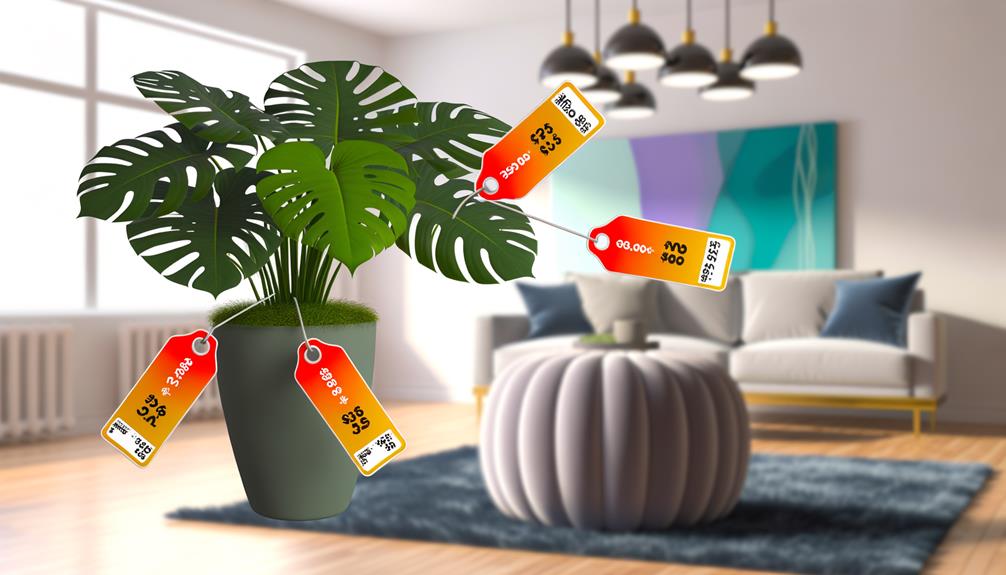
When budgeting for Monstera epipremnoides, expect prices to range from $50 to $200 depending on size, variegation, and seller reputation. This pricing reflects the plant’s rarity and the care required for best growth. Monstera epipremnoides, known for its fenestrated leaves, demands an investment that aligns with its unique characteristics.
Here’s what to take into account:
- Size: Larger specimens command higher prices.
- Variegation: Plants with distinct variegation are more expensive.
- Seller reputation: Established sellers may price higher due to quality assurance.
- Shipping costs: Factor in potential shipping fees for live plants.
Tips for Healthy Growth
To maximize the health of your Monstera epipremnoides after purchase, focus on providing best-suited light, humidity, and soil conditions tailored to its tropical origins. Place it in bright, indirect sunlight to mimic its native understory environment. Maintain humidity levels between 60-80%, using a humidifier if necessary. Use well-draining soil with organic matter to prevent root rot.
| Factor | Ideal Conditions |
|---|---|
| Light | Bright, indirect sunlight |
| Humidity | 60-80% |
| Soil Type | Well-draining, rich in organic matter |
| Watering | Moderate; keep soil slightly moist |
Water moderately, ensuring the soil stays slightly moist but not waterlogged. Feed monthly with a balanced, water-soluble fertilizer during the growing season to support robust growth.
Common Problems and Solutions
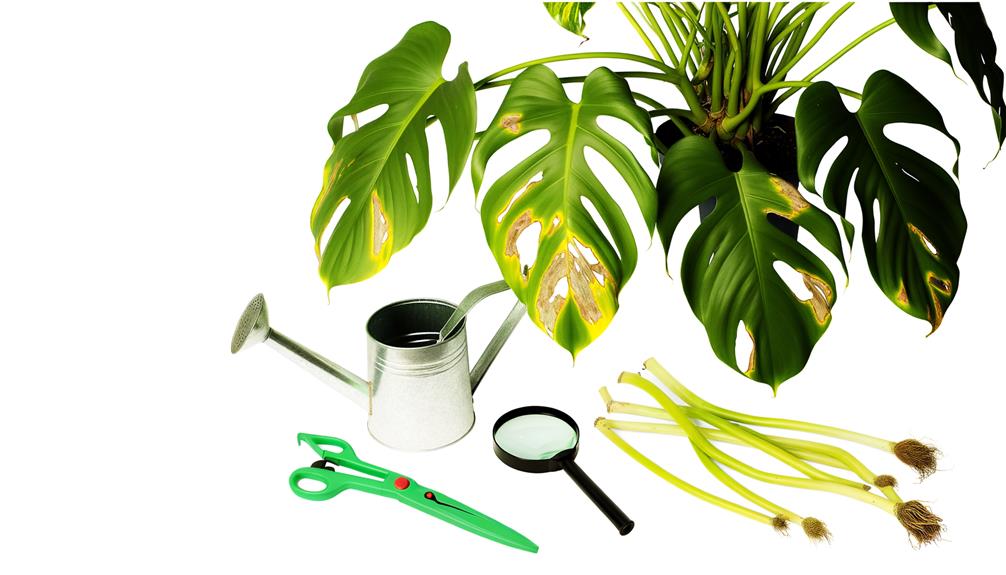
Despite your best efforts, Monstera epipremnoides may encounter issues such as yellowing leaves, root rot, or pest infestations, each requiring specific solutions to guarantee the plant’s health.
Yellowing leaves often signal chlorosis, caused by inadequate light or nutrient deficiencies. Enhance light exposure and supplement with a balanced fertilizer to address this issue.
Root rot, resulting from overwatering or poor drainage, demands immediate action. Prune affected roots and repot the plant in well-draining soil to prevent further damage.
Pest infestations, particularly by spider mites or aphids, necessitate swift treatment with insecticidal soap or neem oil. Additionally, maintaining appropriate humidity levels can help prevent future infestations.
Leaf spot diseases should be addressed by removing affected foliage and enhancing air circulation around the plant.
Proactive care guarantees that Monstera epipremnoides thrives despite these challenges.
Best Potting and Soil Mix
To guarantee your Monstera epipremnoides thrives, use a soil mix that balances aeration and moisture retention. A blend of peat moss, perlite, and orchid bark works well for this purpose. When potting, choose a container with sufficient drainage holes to prevent root rot.
Regularly examine the soil’s pH to ensure optimal conditions for your plant. Aim for a slightly acidic range of 5.5 to 7.
Ideal Soil Composition
For Monstera epipremnoides, achieving peak growth requires a well-draining potting mix rich in organic matter, such as a blend of peat moss, perlite, and orchid bark. This combination ensures sufficient aeration, moisture retention, and nutrient availability.
You should consider the following components for an ideal mix:
- Peat moss: Enhances moisture retention and supports root growth.
- Perlite: Improves drainage and prevents soil compaction.
- Orchid bark: Adds structure and promotes aeration.
- Activated charcoal: Helps absorb toxins and keeps the mix fresh.
When mixing these elements, aim for a balance that maintains humidity without waterlogging. This tailored composition supports Monstera epipremnoides’ epiphytic nature, enabling vigorous growth and healthier foliage. Understanding these elements will help you create the perfect environment for your plant.
Proper Potting Techniques
Consistently repotting Monstera epipremnoides promotes peak root health and growth, requiring careful attention to pot choice, soil mix, and technique.
Select a pot with ample drainage holes to prevent waterlogging, reducing root rot risk. Opt for a well-aerated soil mix: combine equal parts orchid bark, perlite, and peat moss. This mix emulates the plant’s natural epiphytic environment, guaranteeing excellent aeration and moisture retention.
When repotting, gently remove the plant, shake off excess old soil, and trim any damaged roots. Place the Monstera at the same depth as before, backfill with the prepared mix, and water thoroughly.
Ensure the plant receives indirect sunlight and maintain high humidity levels, promoting vigorous growth and lush foliage.
Styling Your Monstera Epipremnoides
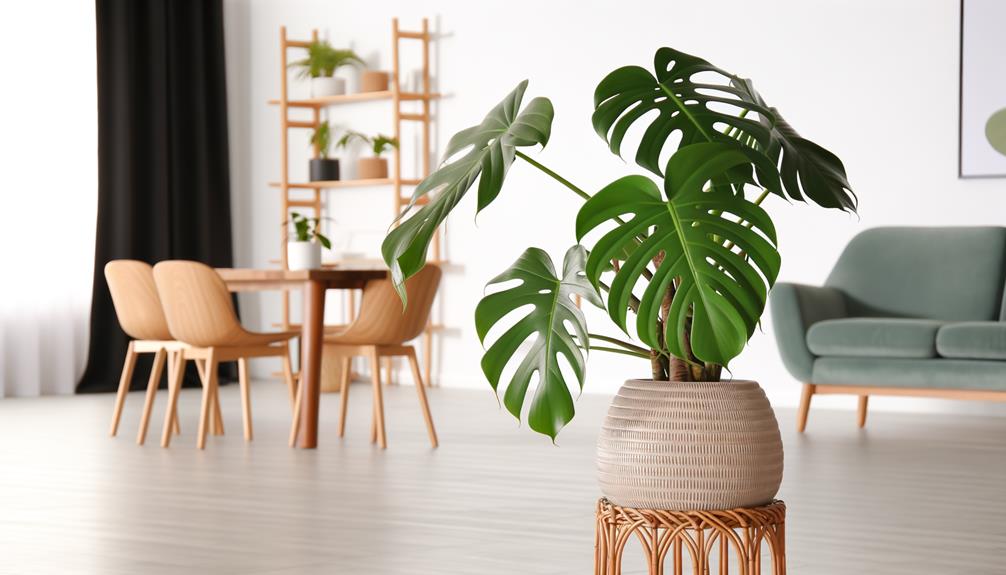
When styling your Monstera epipremnoides, consider utilizing moss poles or trellises to support its climbing nature and promote healthy aerial root development. This epiphytic plant, native to tropical rainforests, thrives with vertical support.
Ensuring proper styling involves:
- Light exposure: Place near bright, indirect light for best photosynthesis.
- Humidity: Maintain humidity levels around 60-70% to mimic natural habitat.
- Pruning: Trim occasionally to manage shape and encourage new growth.
- Feeding: Use a balanced, water-soluble fertilizer every 4-6 weeks during the growing season.
These measures foster a strong, aesthetically pleasing plant. By mimicking its natural environment, you optimize Monstera epipremnoides’ growth indoors, displaying its iconic fenestrated leaves and vigorous growth patterns.
Conclusion
Owning a Monstera epipremnoides can elevate your indoor garden with its unique fenestrated leaves.
Did you know that this species can reach up to 10 feet in height under ideal conditions?
By providing well-draining soil and maintaining humidity levels around 60%, you’ll guarantee robust growth.
Regularly inspect for pests and use a balanced fertilizer to keep your plant thriving.
Whether you buy online or locally, proper care will let this striking plant flourish.

